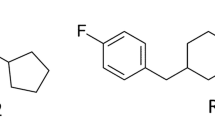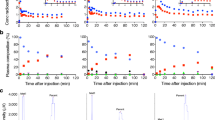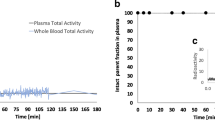Abstract
Purpose
While the selective 5-hydroxytryptamine type 2a receptor (5-HT2AR) radiotracer [18F]altanserin is well established in humans, the present study evaluated its suitability for quantifying cerebral 5-HT2ARs with positron emission tomography (PET) in albino rats.
Procedures
Ten Sprague Dawley rats underwent 180 min PET scans with arterial blood sampling. Reference tissue methods were evaluated on the basis of invasive kinetic models with metabolite-corrected arterial input functions. In vivo 5-HT2AR quantification with PET was validated by in vitro autoradiographic saturation experiments in the same animals.
Result
Overall brain uptake of [18F]altanserin was reliably quantified by invasive and non-invasive models with the cerebellum as reference region shown by linear correlation of outcome parameters. Unlike in humans, no lipophilic metabolites occurred so that brain activity derived solely from parent compound. PET data correlated very well with in vitro autoradiographic data of the same animals.
Conclusion
[18F]Altanserin PET is a reliable tool for in vivo quantification of 5-HT2AR availability in albino rats. Models based on both blood input and reference tissue describe radiotracer kinetics adequately. Low cerebral tracer uptake might, however, cause restrictions in experimental usage.





Similar content being viewed by others
References
Elmenhorst D, Kroll T, Matusch A, Bauer A (2012) Sleep Deprivation Increases Cerebral Serotonin 2A Receptor Binding in Humans. Sleep 35:1615–1623
Frokjaer VG, Mortensen EL, Nielsen FA et al (2008) Frontolimbic Serotonin 2A Receptor Binding in Healthy Subjects Is Associated with Personality Risk Factors for Affective Disorder. Biol Psychiatry 63:569–576
Hurlemann R, Matusch A, Kuhn KU et al (2008) 5-HT2A receptor density is decreased in the at-risk mental state. Psychopharmacology 195:579–590
Pazos A, Cortés R, Palacios JM (1985) Quantitative Autoradiographic Mapping of Serotonin Receptors in the Rat Brain. II. Serotonin-2 Receptors. Brain Res 346:231–249
Kristiansen H, Elfving B, Plenge P et al (2005) Binding Characteristics of the 5-HT2A Receptor Antagonists Altanserin and MDL 100907. Synapse 58:249–257
Haugbol S, Pinborg LH, Arfan HM et al (2007) Reproducibility of 5-HT2A receptor measurements and sample size estimations with [18F]altanserin PET using a bolus/infusion approach. Eur J Nucl Med Mol Imaging 34:910–915
Pinborg LH, Adams KH, Svarer C et al (2003) Quantification of 5-HT2A Receptors in the Human Brain Using [18F]Altanserin-PET and the Bolus/Infusion Approach. J Cereb Blood Flow Metab 23:985–996
Tan PZ, Baldwin RM, Van Dyck CH et al (1999) Characterization of radioactive metabolites of 5-HT2A receptor PET ligand [18F]altanserin in human and rodent. Nucl Med Biol 26:601–608
Riss PJ, Hong YT, Williamson D et al (2011) Validation and quantification of [18F]altanserin binding in the rat brain using blood input and reference tissue modeling. J Cereb Blood Flow Metab 31:2334–2342
McDermott C, Kelly JP (2008) Comparison of the behavioural pharmacology of the Lister-Hooded with 2 commonly utilised albino rat strains. Prog Neuropsychopharmacol Biol Psychiatry 32:1816–1823
Parsons MJ, Benca RM, Brownfield MS, Behan M (2001) Age-associated changes in the serotonergic system in rat superior colliculus and pretectum. Brain Res Bull 55:435–444
Hamacher K, Coenen HH (2006) No-carrier-added nucleophilic 18F-labelling in an electrochemical cell exemplified by the routine production of [18F]altanserin. Appl Radiat Isot 64:989–994
Maeshima T, Shutoh F, Hamada S et al (1998) Serotonin2A receptor-like immunoreactivity in rat cerebellar Purkinje cells. Neurosci Lett 252:72–74
Innis RB, Cunningham VJ, Delforge J et al (2007) Consensus nomenclature for in vivo imaging of reversibly binding radioligands. J Cereb Blood Flow Metab 27:1533–1539
Gunn RN, Gunn SR, Cunningham VJ (2001) Positron Emission Tomography Compartmental Models. J Cereb Blood Flow Metab 21:635–652
Adam J, Elleaume H, Le Duc G et al (2003) Absolute cerebral blood volume and blood flow measurements based on synchrotron radiation quantitative computed tomography. J Cereb Blood Flow Metab 23:499–512
Logan J, Fowler JS, Volkow ND et al (1990) Graphical Analysis of Reversible Radioligand Binding from Time-Activity Measurements Applied to [N-11C-methyl]-( − )-Cocaine PET Studies in Human Subjects. J Cereb Blood Flow Metab 10:740–747
Ichise M, Toyama H, Innis RB, Carson RE (2002) Strategies to improve neuroreceptor parameter estimation by linear regression analysis. J Cereb Blood Flow Metab 22:1271–1281
Lammertsma AA, Hume SP (1996) Simplified Reference Tissue Model for PET Receptor Studies. NeuroImage 4:153–158
Wu Y, Carson RE (2002) Noise reduction in the simplified reference tissue model for neuroreceptor functional imaging. J Cereb Blood Flow Metab 22:1440–1452
Logan J, Fowler JS, Volkow ND et al (1996) Distribution Volume Ratios Without Blood Sampling from Graphical Analysis of PET Data. J Cereb Blood Flow Metab 16:834–840
Ichise M, Loiw JS, Lu JQ et al (2003) Linearized Reference Tissue Parametric Imaging Methods: Application to [11C]DASB Positron Emission Tomography Studies of the Serotonin Transporter in Human Brain. J Cereb Blood Flow Metab 23:1096–1112
Mintun MA, Raichle ME, Kilbourn MR, Wooton GF, Welch MJ (1984) A Quantitative Model for the In Vivo Assessment of Drug Binding Sites with Positron Emission Tomography. Ann Neurol 15:217–227
López-Giménez JF, Mengod G, Palacios JM, Vilaró MT (1997) Selective visualization of rat brain 5-HT2A receptors by autoradiography with [3H]MDL 100,907. Naunyn-Schmiedeberg’s Arch Pharmacol 356:446–454
Paxinos G, Watson C (1998) The rat brain in stereotaxic coordinates. Academic Press, San Diego
Chen F, Lawrence AJ (2003) The effects of antidepressant treatment on serotonergic and dopaminergic systems in Fawn–Hooded rats: a quantitative autoradiography study. Brain Res 976:22–29
Sato H, Skelin I, Diksic M (2010) Chronic buspirone treatment decreases 5-HT1B receptor densities and the serotonin transporter but increases the density of 5-HT2A receptors in the bulbectomized rat model of depression: an autoradiographic study. Brain Res 1345:28–40
Syvänen S, Lindhe Ö, Palner M et al (2009) Species Differences in Blood–brain Barrier Transport of Three Positron Emission Tomography Radioligands with Emphasis on P- Glycoprotein Transport. Drug Metab Dispos 37:635–643
Preece MA, Dalley JW, Theobald DEH, Robbins TW, Reynolds GP (2004) Region Specific Changes in Forebrain 5-Hydroxytryptamine1A and 5-Hydroxytryptamine2A Receptors in isolation-reared Rats: An in vitro autoradiographic Study. Neuroscience 123:725–732
Hamada S, Senzaki K, Hamguchi-Hamada K et al (1998) Localization of 5-HT2A Receptor in rat cerebral cortex and olfactory system revealed by immunohistochemistry using two antibodies raised in rabbit and chicken. Mol Brain Res 54:199–211
Xu T, Pandey SC (2000) Cellular localization of serotonin2A (5HT2A) receptors in the rat brain. Brain Res Bull 51:499–505
Biver F, Lotstra F, Monclus M et al (1997) In vivo binding of [18F]altanserin to rat brain 5HT2 receptors: a film and electronic autoradiographic study. Nucl Med Biol 24:357–360
Elmenhorst D, Minuzzi L, Aliaga A et al (2010) In vivo and in vitro validation of reference tissue models for the mGluR5 ligand [11C]ABP688. J Cereb Blood Flow Metab 30:1538–1549
Gallezot JD, Nabulsi N, Neumeister A et al (2010) Kinetic modeling of the serotonin 5-HT1B receptor radioligand [11C]P943 in humans. J Cereb Blood Flow Metab 30:196–210
Meyer PT, Bhagwagar Z, Cowen PJ et al (2010) Simplified quantification of 5-HT2A receptors in the human brain with [11C]MDL 100,907 PET and non-invasive kinetic analyses. NeuroImage 50:984–993
Forutan F, Estalj S, Beu M et al (2002) Distribution of 5HT2A receptors in the human brain: comparison of data in vivo and post mortem. Nuklearmedizin 41:197–201
Strome EM, Cepeda IL, Sossi V, Doudet DJ (2006) Evaluation of the Integrity of the Dopamine System in a Rodent Model of Parkinson’s Disease: Small Animal Positron Emission Tomography Compared to Behavioral Assessment and Autoradiography. Mol Imaging Biol 8:292–299
Fischer K, Sossi V, von Ameln-Mayerhofer A, Reischl G, Pichler BJ (2012) In vivo quantification of dopamine transporters in mice with unilateral 6-OHDA lesions using [11C]methylphenidate and PET. NeuroImage 59:2413–2422
Manook A, Yousefi BH, Willuweit A et al (2012) Small-Animal PET Imaging of Amyloid-Beta Plaques with [11C]PiB and Its Multi-Modal Validation in an APP/PS1 Mouse Model of Alzheimer’s Disease. PLoS One 7:e31310
Acknowledgments
Magdalene Vögeling, Sabine Wilms, Babara Elghahwagi, and Dorothe Krug are gratefully acknowledged for their excellent technical assistance. Claudia Kuntner kindly provided the software for time-logging of blood sampling. We thank Nikola Kornadt-Beck for valuable discussions. Tanja Juraschek, Steffi Holz, and Larissa Damm took care of the animal housing. Johannes Ermert and Heinz H. Coenen are gratefully acknowledged for the supply of the radioligand as well as Avdo Celik and N. Jon Shah for providing MRI equipment.
Disclosure/Conflict of Interest
The authors have no conflicts of interest to disclose.
Author information
Authors and Affiliations
Corresponding author
Rights and permissions
About this article
Cite this article
Kroll, T., Elmenhorst, D., Matusch, A. et al. Suitability of [18F]Altanserin and PET to Determine 5-HT2A Receptor Availability in the Rat Brain: In Vivo and In Vitro Validation of Invasive and Non-Invasive Kinetic Models. Mol Imaging Biol 15, 456–467 (2013). https://doi.org/10.1007/s11307-013-0621-3
Received:
Revised:
Accepted:
Published:
Issue Date:
DOI: https://doi.org/10.1007/s11307-013-0621-3




